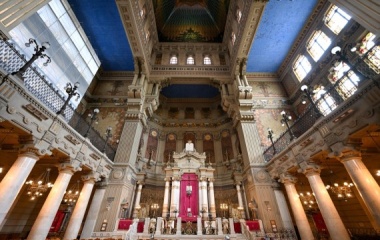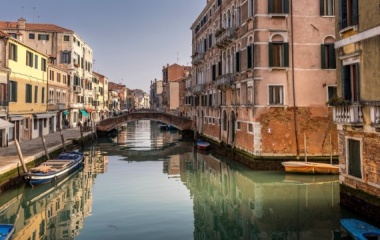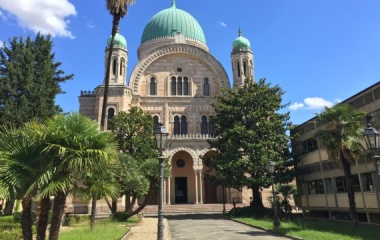
“Therefore it is our duty to thank, praise, laud, glorify, exalt, honor, bless, raise high, and acclaim the One who has performed all these miracles for our ancestors and for us; who has brought us out from slavery to freedom, from sorrow to joy, from grief to celebration; from darkness to great light and from enslavement to redemption; and so we shall sing a new song before Him” (Haggadah shel Pesach).
If a Jew who was forced to live in the ghetto in Rome could only see the “ghetto” today there would be few words to better describe what they see. Hundreds of Jews, and non-Jews, of all stripes strolling down the beautiful street attesting to a vibrant Jewish life. Some 15 kosher restaurants, cafes, eateries, line the street with people eating indoors and out, enjoying themselves with nary a worry about proudly expressing their Jewishness.
What a beautiful site as Jews of all backgrounds join together to daven mincha – and after dinner maariv – in the middle of the "ghetto". People in black (baseball) hats, white button down shirts, white tennis shirts, shorts, black pants and payot joining together. If only we could have such a variety in our minyanim back “home”. There is something about travel that encourages “strangers” to be friendly with each other.
Walking in the ghetto today reminds one that despite the rise in anti-Semitism, there has been no better time, likely since the times of King David and Shlomo, to live as a Jew than today. While we have not yet reached the messianic era, never before in history have Jews had the freedoms we have today, nor reached the levels of success and comfort so many have today.
At the edge of the old ghetto is the Great Synagogue of Rome – and it is grand. Build between 1901-1904, some 30 years after the destruction of the ghetto it takes up a city block. It is some 150 feet tall and like so many of shus in Europe is beautifully decorated, architecturally beautiful, even ornate.
It was, an still is, an important symbol of the emancipation of the Jewish people in Rome[1].
Having arrived in Rome before the Common Era, Italian Jewry is neither Ashkenazic or Sephardic. The nusach, rites of prayer, is what me might call Nusach Italy, or in Rome, Nusach Roma. As Italy only became a united country in 1861, with Rome becoming part of Italy only in 1870, the minhagim of Rome, Florence and Venice, while similar, have their distinct characteristics. In other words, the siddur in Rome and that in Florence are not the same.
In Rome, “le’eilah le’eilah” is said at every kaddish and not only during the aseret yemi teshuva. In all the communities we visited only the first paragraph of aleinu was recited and in Florence aleinu is not recited at mincha[2]. The rabbi in Florence explained that the first paragraph of aleinu reiterates the primary theme of the shema – that we worship the one G-d – and hence is said only at shacharit and maariv when we say the shema. This would also explain the custom in Italy to end that first paragraph of aleinu with the first line of the shema yisrael and might also explain why only the first paragraph of aleinu is said. It is worth noting that aleinu originated in the malchiot section of mussaf of Rosh Hashanah and the two paragraphs in the repetition of the amidah at leastare not back to back but two separate sections.
The custom I most loved was towards the conclusion of ein k’Eloheinu, in the middle of the last paragraph discussing Torah scholars, the rabbi gives a short devar Torah and only then is ein k’Eloheinu finished and kaddish derabbanan, the rabbinic kaddish recited.
Not only does Italian Jewry pre-date Ashkenazim and Sephardim they were totally uninvolved in the battles between Reform and Orthodoxy and religious reforms. Hence what would get a shul excommunicated in Hungary was, and is, a non-issue in Italy.
It should not be surprising that when walking into the shul in Rome one of the first things one notices is that the bimah is not in the middle of the shul. While this was a major issue of debate between the Orthodox and Reform in Hungary, in Italy there no Reform and hence no Orthodox. Italy was and is – as were all pre-modern communities – a traditional community with no need to react to (non-existent) religious reforms. And the placement of the bimah – even if was traditionally placed in the middle - was not an issue one way or another and surely not an issue to fight over.
Moreover, the custom in Italy was to play the organ in shul, even on Shabbat. On Shabbat afternoon we studied the teshuva, responsa, of the Yair Nativ, by Rav Yaakov Recanati, Chief Rabbi of Verona, regarding playing the organ in a shul. The teshuva was written in 1817, as Reform was beginning in Germany[3]. Briefly summarizing his teshuva, he cited three possible reasons to forbid such in shul and then explained why they did not apply. The first issue – and one that was so crucial in the battles with Reform – is that since an organ is used in the Church it is prohibited due to prohibition of following the religious practices of the non-Jews, similar to how the Torah banned the mazevah, a type of religious monument, once it became a pagan practice. He argues if such is the case we could not use candles as they too are used in church services.
Secondly, in light of the destruction of the Temple, our Sages forbade the the playing of musical instruments and in some circumstances even singing[4]. However, if the songs are shirot vtishbachot, songs of honour to G-d, then the music becomes permissible – including the playing of the organ. The third potential issue is that the organ rhythms may not fully correspond to the proper rhythms of the siddur, an argument he dismisses out of hand. For us moderns who use all kinds of (often inappropriate) tunes for davening such an argument cannot be taken seriously.
The above relates to the playing of the organ during the weekday. On shabbat he argued that playing the organ would be permissible provided it was played by a non-Jew[5].
But as the world became a global village and no community could live in total isolation, by the 1960’s the playing of the organ was no longer possible – at least on Shabbat, though the organ pipes are clearly visible in many a shul. And in Florence while the organ is no longer played on Shabbat it is still played at weddings.
[1] Another common feature of these older beautiful shuls is the lack of air conditioning. In the 19th and early 20th century air conditioning was not on the agenda and the cost to add it today would be prohibitive. It is fascinating that Rav Moshe Feinstein rules that while one can ask a non-Jew to turn on the heat on Shabbat, one may not ask one to turn on the air conditioning on Shabbat. I think today we understand it is just as uncomfortable and dangerous to have too much heat as too much cold.
[2] The minhag is some Ashkenazic communities – I have seen this at Breuers – is that aleinu is not said if maariv is davened immediately after mincha. This minhag understands that aleinu is not the conclusion of each prayer but is to be said before leaving shul. Thus if mincha and maariv are davened back to back aleinu would only be said after maariv.
This explains why there is aleinu is not said after mussaf of Yom Kippur. Apparently, unlike the common practice today, there was no break between mussaf and mincha and hence no need to say aleinu.
[3] It is not by chance that the German reformers sent their question to Italy. They wanted an answer that discussed the halachic issues only, something not possible in the heat of the battle with Reform.
It is important to note that the early “reformers” justified (or at least tried to justify) their innovations on legal, halachic, grounds. One can only speculate how the trajectory of religious life might have turned out if the traditional rabbis (they would not be called Orthodox for another generation or two) had sought accommodation with the early reformers .
[4] This is why many in Jerusalem follow the practice to only allow one drummer if a wedding is held in Jerusalem
[5] This is based on the principle of shevut d'shevut b'makon mitzva, that one is allowed to ask a non-Jew to violate a rabbinic command (and playing instruments on Shabbat is a rabbinic prohibition) for the purpose of a mitzva.
It is for this reason the Shulchan Aruch (Orach Chaim 338:2) allows the hiring of a non-Jewish band to play at wedding meal taking place on Shabbat.



